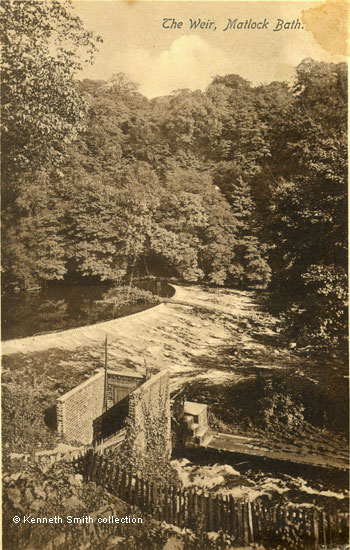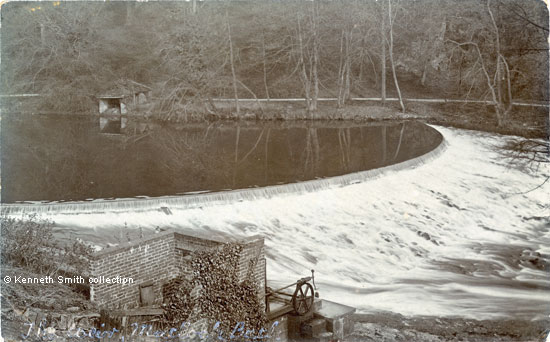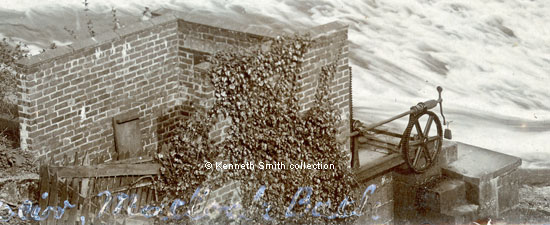|
Images Index> Matlock Bath, 20th and 21st Century Images> This page |
| Matlock Bath: River Derwent, Masson Weir |
| Matlock Bath : Twentieth Century Photographs, Postcards, Engravings & Etchings |
|
|||||||
The elegantly curved weir didn't meet with everyone's approval.
Fifty years after it was built Ebenezer Rhodes
questioned why Masson Mill had ever been built in the
valley; he thought the weir was "incongruous and out
of place",
but conceded that anywhere else it "might be a pleasing
object"![3] William
Adam, in contrast, talks of entering the Dale of Matlock
Bath from its southern end and, where the road suddenly turns
north, "disclosing
at once the splendid rocks which burst upon the view through
a fine opening up the river, exhibiting a beautiful waterfall,
foaming over the "weir" and
rough bed below it, also the wild Cat Tor and Masson Mill"[4].
The inquest of an 1892 boating disaster provides more information about the goit and the area around its entrance. At that time warning notices along the riverbank were placed about 50 yards above the weir, telling boating parties not to go any further. The group involved in the 1892 disaster had reached the point where they should have turned round but, unfortunately, they saw that the water levels were low and noticed that no water was going over the weir itself so assumed themselves safe, ignored the signs, and rowed closer. They did not realise that the water at that point was, and still is, drawn into the large mill race (the goit) and they became caught in the current that was rushing down into it. The entry to the goit was described as being ten feet deep, and about four yards across; it was about twenty feet below Derby Road[11]. From several of the images on this page we can see that the goit then narrows by the sluice, thus forcing the water through before it reached the shuttle in front of the wheel at the mill. The second picture from the top gives us a good idea of the speed and turbulence of the water, as we can see it tumbling over the rocks. There was said to be 300 horse power of water going down it when the accident occurred[12]. The inquest recommended that the goit should be protected.
|
|||||||
1. "The Weir, Matlock Bath". Copyright H, Coates, Wisbech, No. 2390. Not posted, but could date from 1930. Another card was posted in 1941. Image © Ann Andrews collection. 2. "The Weir Matlock Bath". Jackson & Sons, Publishers, Grimsby, No.275. Written and posted at Matlock on 27 Oct 1912. The writer was staying at "Woodfields" (see Kelly's 1912 Directory) and reported that there had been 3" of snow but the weather was mild again. Image © Ken Smith collection. Another card was posted in 1911. 3 and 4. "The Weir, Matlock Bath". No publisher and not posted. Image © Ken Smith collection. 5 and 6. "The Weir Matlock Bath. A photograph by TMH - Thomas Meredith Henshall. Posted at Matlock Bath on 12 Aug 1913. Image © Ken Smith collection. Information researched, written by and © Ann Andrews. Intended for personal use only. |
|||||||
References (coloured links are to transcripts or more information elsewhere on this web site): [1] See The Wolley Manuscripts Vol. 6670 f.90d (Notes of the building of the paper mill, by Shore and White, 1771) | Vol. 6671 ff.310-313 (Manorial deeds and papers ... to convey water to the paper mill 1772). [2] "The Derwent Valley Mills and their Communities", published by The Derwent Valley Mills Partnership, County Hall, Matlock, Derbyshire, DE4 3AG, 2001. ISBN 0-9541940-0-4. "The earlier paper mill on part of this site [i.e. Masson Mill] would not have justified the construction of a weir on this scale". [3] Rhodes, Ebenezer (1824) "Peak Scenery" pub. London, Longman, Hurst, Rees, Orme, Brown, and Green, Paternoster Row. [4] Adam, W. (1838) "The Gem of the Peak; or Matlock Bath and Its Vicinity. ..." London; Longman & Co., Paternoster Row ; ... Mawe, Royal Museum, Matlock ; .... This was the first edition of his guide and her repeated his praise in later editions.. [5] "The Derby Mercury", 13 July 1842. The quarry man was, unfortunately, seriously injured and had been taken home "where he lies without any apparent hopes of recovery". The quarry was not specified in the newspaper report. [6] The noun "ghaut" seems to have been used instead of goit or goyt (meaning the side stream or mill race) on occasion in the 1860s. Bryan, Benjamin (1903) "History of Matlock - Matlock, Manor and Parish" London by Bemrose & Sons, Limited also used the spelling. [7] "The Derby Mercury", 15 December 1847. Flood. [8] "Derbyshire Advertiser and Journal", 8 August 1856. Peter Arkwright v Francis Blake. The case was to prevent Blake "from further proceeding to discharge or unload into the river Derwent at Matlock Bath, any stones, earth, or rubbish, dug or taken from the defendant's limestone quarries, or elsewhere; and also to restrain him from raising or building a wall in the bed or waterway of the river, and from extending or otherwise proceeding with the wall already built by the defendant in the bed or waterway of the same river ... to the detriment of the plaintiff's property". Arkwright owned land in fee simple and Blake owned some portions on the opposite bank. Both were entitled to the soil on the riverbed but to abstain from doing anything that may injure the other, either directly or indirectly. When Blake had opened two limestone quarries on his land next to the river (just before May 1855) his servants and workmen threw and discharged large quantities of unbroken stones, earth and rubbish which had been dug, gradually forming embankments or mounds. This resulted in the channel being narrowed. Although Blake was given notice he disregarded it and built a wall along a part of the embankments. [9] "Derbyshire Courier", 8 September 1860. Remarkable escape from drowning. This was the first record I have been able to find of the word "ghaut". [10] "The Derby Mercury", 26 September 1866. Providential escape of four persons from drowning. [11] "Nottinghamshire Guardian", 13 August 1892. Boating disaster at Matlock Bath. "The water at this point is drawn into a large mill race or goyt to run the motive power of the Masson Mills and the paper mills of Messrs. Simmonds and Pickard, Nottingham". [12] "Nottingham Evening Post", 13 August 1892. [13] "Derby Daily Telegraph" and "Nottingham Evening Post", 7 September 1931. [14] "Derbyshire Times and Chesterfield Herald", 24 January 1891. [15] Mr. Jordan was living at 1 Masson
Cottages in the 1891 census.
This row of houses was later called Masson Terrace and was on
the opposite side of the road from the weir. His widow was still
there in 1901. William was buried at Holy Trinity : see
his MI. Also see Matlock
Bath: Winter Scenes, 1947 and Matlock
Bath: Winter Scenes, 1960-70 |











